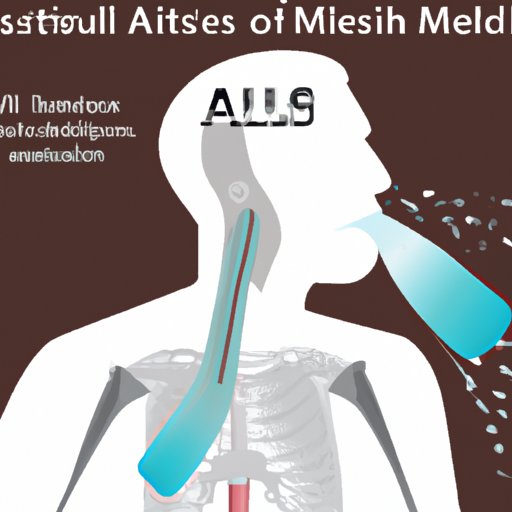
Introduction
Amyotrophic Lateral Sclerosis, or ALS, is a neurodegenerative disease that affects the nerve cells in the brain and spinal cord. ALS is a rare disease that affects people of all ages and races. It is a progressive disease, meaning it worsens over time. In this article, we will explore the symptoms of ALS, how to identify them, and the importance of seeking medical attention if you or a loved one has any symptoms.
Uncovering the Telltale Signs of ALS: A Comprehensive Guide to Understanding the Symptoms
ALS affects the nerve cells responsible for controlling voluntary muscles such as those used for walking, talking, and breathing. As the disease progresses, these muscle cells die, leading to muscle weakness and eventually paralysis. There is currently no cure for ALS, and treatment is focused on managing symptoms and improving the patient’s quality of life.
The most common symptoms of ALS include muscle weakness, twitching, and difficulty swallowing. Early symptoms of the disease can be subtle and may be mistaken for other conditions. It is crucial to recognize the signs of ALS early as the disease progresses rapidly, and early intervention can significantly improve the patient’s prognosis.
10 Warning Signs You May Have ALS
Here are ten common symptoms of ALS to look out for:
- Difficulty walking or tripping frequently
- Muscle cramps and twitching, especially in the arms and legs
- Difficulty speaking or swallowing
- Weakening grip strength and difficulty with fine motor skills
- Unintentional weight loss
- Spasticity- stiff or tight muscles
- Excessive fatigue and lack of energy
- Slurred speech
- Difficulty breathing or shortness of breath
- Inability to hold the head up or control neck movements
If you experience any of these symptoms, it is crucial to seek medical attention and inform your doctor about your concerns and symptoms. The earlier the disease is detected, the better the patient’s chances of successful treatment and improved quality of life.
The Silent Signs of ALS: Recognizing the Unseen Symptoms
While the common symptoms of ALS are often well-known, there are also several lesser-known symptoms that may indicate the presence of the disease. These “silent” symptoms can be a sign of ALS or another condition and are often overlooked or attributed to other causes.
Some silent symptoms of ALS include:
- Depression or changes in mood
- Changes in cognition or behavior
- Fasciculations- continuous, involuntary muscle twitching that was not present earlier.
- Excessive drooling and difficulty controlling saliva
- Constipation and difficulty controlling bowel movements
How to Know if You or a Loved One Has ALS: Guidance on Identifying Symptoms
If you or a loved one has symptoms that may indicate the presence of ALS, it is essential to consult a medical professional as soon as possible. Your doctor can perform a series of tests and ask about any concerning symptoms to determine whether ALS is present.
Tests may include a physical exam, a neurological exam, an MRI or CT scan, and an electromyography (EMG) test to measure the electrical activity of muscle cells. After the various tests, the doctor will refer you to a neurologist who will continue the workup by performing further tests to check if all the symptoms point to the diagnosis of ALS.
Breaking Down the Symptoms of ALS: What You Need to Know
Each symptom of ALS affects the body differently and progresses at varying rates. Here is a breakdown of some of the most common symptoms:
Muscle weakness
Muscle weakness is often the earliest symptom of ALS. It typically starts in the limbs before moving on to other parts of the body. Muscles may become progressively weaker over time, leading to difficulty standing, walking, or holding objects.
Twitching
Twitching or fasciculations are involuntary muscle movements common in ALS patients. They can occur anywhere in the body, are usually painless, and cannot be controlled by the affected person.
Difficulty swallowing
ALS affects the muscles responsible for swallowing, leading to difficulty swallowing, drooling, and choking.
Difficulty speaking
The disease can also affect the muscles required for speaking, leading to slurred speech, slow speech, or difficulty articulating words.
The progression of ALS varies significantly from person to person, and some symptoms may present earlier than others. Some patients can live for several years without severe symptoms, while others may rapidly progress.
Conclusion
If you or someone you know is experiencing any of the symptoms mentioned in this article, it is essential to seek medical attention as soon as possible. While there is currently no cure for ALS, early diagnosis and intervention can greatly improve the patient’s prognosis and quality of life. By understanding the symptoms of ALS, you can help recognize the signs of the disease and make informed decisions about your health.




